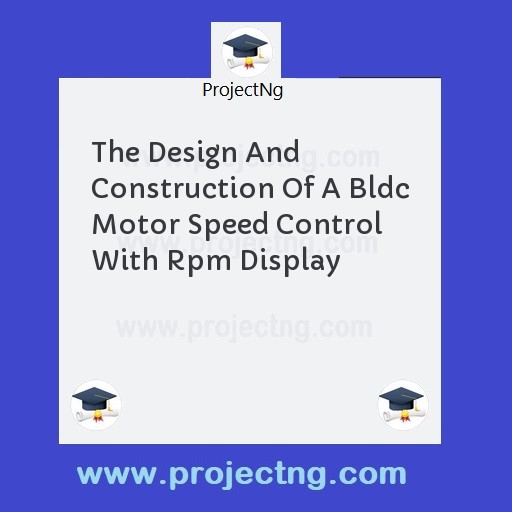The Design And Construction Of A Bldc Motor Speed Control With Rpm Display
Seminars Project Topics
Get the Complete Project Materials Now! »
THE DESIGN AND CONSTRUCTION OF A BLDC MOTOR SPEED CONTROL WITH RPM DISPLAY
ABSTRACT
Following the sensitivity of electronics devices to control the speed of a BLDC motor, there is need to develop RPM display system which is responsible for display of duty cycle % and revolution per minute of the system. The answer to this is to design and construct a brushless DC motor speed control with RPM display . It is a device that is capable of giving a constant measure and revolution per minute of DC motor speed .The device comprises of interface, switching circuit and DC motor/ fan, micro-controller. The power supply comprises of 12v transformer, half-rectifier which converts the ac supply into dc voltage and regulated to 5v/12v dc switching circuit. The device is used to control the speed of motor and as well take % of duty cycle. Also, the analysis of the circuits and calculations were properly done to understand the circuit behavior, while the design follows. Basically, the entire report is written in six chapters, chapter one thus introduces BLDC motor and speed control. Chapter two presents literature review, while chapter three surveys design methodology and materials. Chapter four highlighted the system design and calculation. Chapter five covers cost analysis, implementation, testing, casing and assembling. Chapter six is recommendation and conclusion.
TABLE OF CONTENTS
Title Page i
Certification ii
Approval Page iii
Dedication iv
Acknowledgment v
Abstract vi
Table of Contents vii
CHAPTER ONE
Introduction
1.1 The background
1.2 The aim & objectives of the project
1.3 The Scope and the Limitation
1.1 Definitions of Key Terms
CHAPTER TWO
Literature Review
2.1 History
CHAPTER THREE
1.2 Design methodology
1.3 Block diagram
1.4 Block diagram description
1.5 System complete circuit diagram
1.6 Component description
1.7 Choice of Design
1.8 System Block Diagram
1.9 Description of Block Diagram
CHAPTER FOUR
Design procedure
4.1.
4.2.
4.3.
CHAPTER FIVE
Testing and analysis
5.1. Package over
5.2. Assembling sequence
CHAPTER SIX
6.1. Recommendation
6.2. Conclusion
6.3. Reference
CHAPTER ONE
1.0 INTRODUCTION
The advent of the internet has resulted in many new opportunities for the creation and delivery of content in digital form. Applications include electronic advertisement, real time video and audio delivery, digital repositories and libraries, and web publishing. An important issue that arises in these applications is the protection of the rights of all participants. It has been recognized for quite some time that current copy right laws are inadequate for dealing with digital data. This has led to an interest towards developing new copy deterrence and protection mechanisms. One such effort that has been attracting increasing interest is based on digital camera (pill camera) techniques. Digital camera is the process of embedding information into digital multimedia content such that the information can later be extracted or detected for a variety of purposes including copy prevention and control. Digital camera has become an active and important area of research, and development and commercialization of digital camera techniques is being deemed essential to help address of the challenges faced by the rapid proliferation of digital content.
In the rest if this chapter we assume that content being digitally made is a still image, though most digital camera techniques are, in principle, equally applicable to audio and video data. A digital camera can be visible or invisible. A visible camera typically consists of a conspicuously visible message or a company logo indicating the ownership. On the other hand, invisibly camera image appears very similar to the original. The existence of an invisibly digital camera can only be determined using an appropriate digital camera extraction or detection algorithm. In this chapter we restrict our attention to invisible cameras.
An invisible camera technique, in general, consists of an encoding process and a decoding process.
1.1 Sub-techniques
The authorized dealers and system integrators for most of the manufacturers of video and machine vision components. It offers video and machine vision camera and accessories, lighting (fluorescent, fiber-optic, and LED), lenses, image capture device (frame grabbers), machine vision software, and cables (off-the-shelf and custom). The full system is available or component only.
1.2 Conclusion
In conclusion, image content authentication using a visual hash function and then embedding this hash using a robust digital camera is a compromising area and will see many development in the coming years. This is difficult problem and doubt if there will ever be a completely satisfactory solution. The main reason for this being that there is no clear definition of image content and small changes to an image could potentially lead to different content.
Be the First to Share On Social

Enjoying our content?
Don't miss out on new videos! Subscribe to our YouTube channel for more awesome content.
Subscribe Now!













